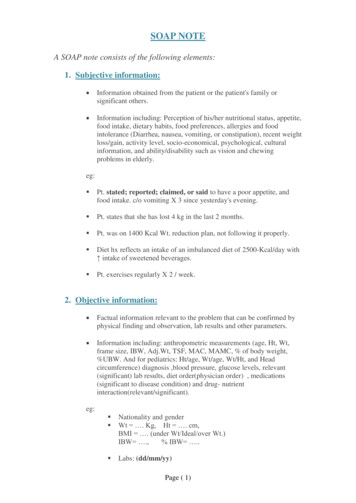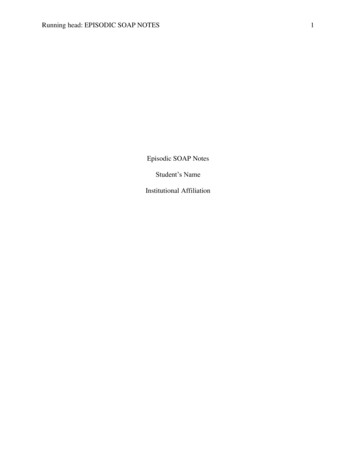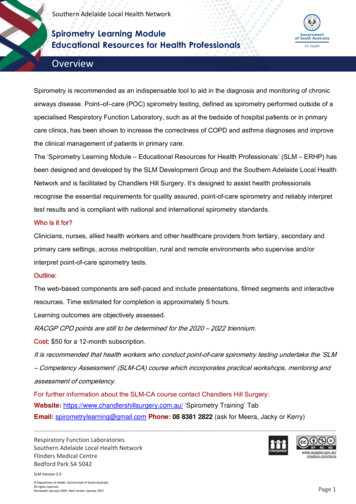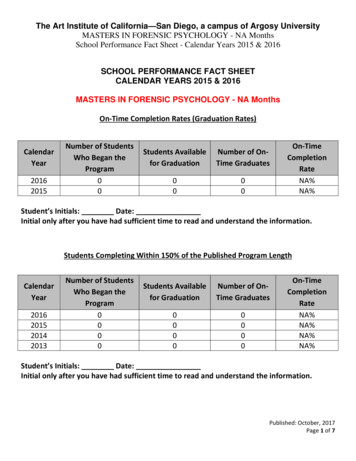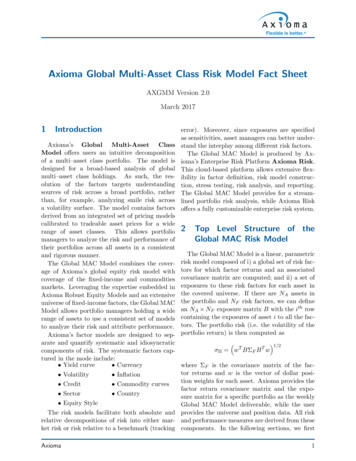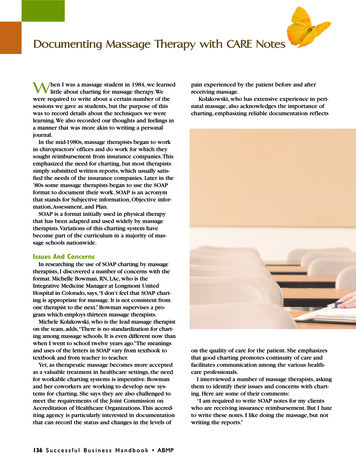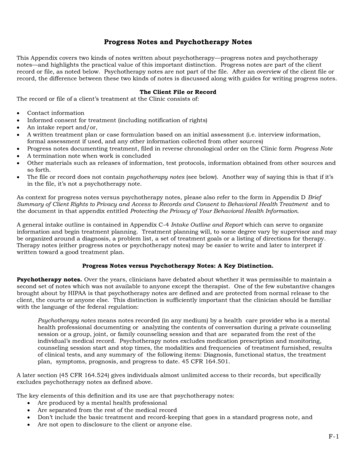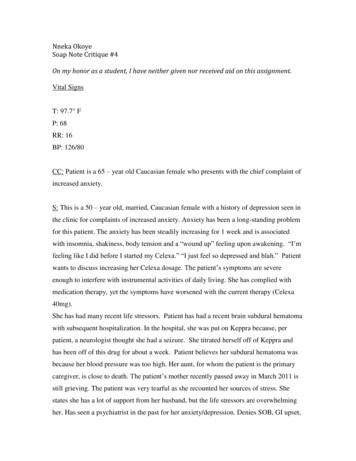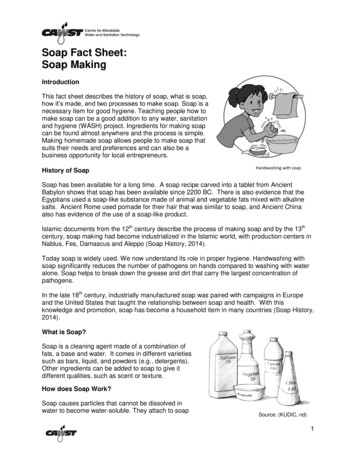
Transcription
Soap Fact Sheet:Soap MakingIntroductionThis fact sheet describes the history of soap, what is soap,how it’s made, and two processes to make soap. Soap is anecessary item for good hygiene. Teaching people how tomake soap can be a good addition to any water, sanitationand hygiene (WASH) project. Ingredients for making soapcan be found almost anywhere and the process is simple.Making homemade soap allows people to make soap thatsuits their needs and preferences and can also be abusiness opportunity for local entrepreneurs.History of SoapHandwashing with soapSoap has been available for a long time. A soap recipe carved into a tablet from AncientBabylon shows that soap has been available since 2200 BC. There is also evidence that theEgyptians used a soap-like substance made of animal and vegetable fats mixed with alkalinesalts. Ancient Rome used pomade for their hair that was similar to soap, and Ancient Chinaalso has evidence of the use of a soap-like product.Islamic documents from the 12th century describe the process of making soap and by the 13thcentury, soap making had become industrialized in the Islamic world, with production centers inNablus, Fes, Damascus and Aleppo (Soap History, 2014).Today soap is widely used. We now understand its role in proper hygiene. Handwashing withsoap significantly reduces the number of pathogens on hands compared to washing with wateralone. Soap helps to break down the grease and dirt that carry the largest concentration ofpathogens.In the late 18th century, industrially manufactured soap was paired with campaigns in Europeand the United States that taught the relationship between soap and health. With thisknowledge and promotion, soap has become a household item in many countries (Soap History,2014).What is Soap?Soap is a cleaning agent made of a combination offats, a base and water. It comes in different varietiessuch as bars, liquid, and powders (e.g., detergents).Other ingredients can be added to soap to give itdifferent qualities, such as scent or texture.How does Soap Work?Soap causes particles that cannot be dissolved inwater to become water-soluble. They attach to soapSource: (KUDIC, nd)1
Soap Fact Sheet: Soap Makingparticles and are washed away when rinsed with water. Think about dirty, greasy dishes. If youonly rinse them with water, they still feel greasy. However, if you add soap to the water, thegrease washes away, and the result is clean dishes.How to Make SoapKey IngredientsThere are 3 key ingredients in soap: oil or fat, lye and water.1. Oil or fat — beeswax, aloe butter, coconut oil, coffee bean oil, moringa oil, animal fat, palmoil, and shea butter2. Lye — sodium hydroxide (NaOH) or potassium hydroxide (KOH)3. Water — bottled, filtered or distilled waterLyeLye is one of the main ingredients in soap. Lye is a base, also known as an alkali. Bases canburn and destroy living tissue—such as plants and skin. It can also burn through certain metalssuch as aluminum.Lye should be handled with care and should always be kept away fromchildren, flammable materials and aluminum containers. We recommendwearing gloves and long sleeves when working with lye. Vinegar canneutralize lye. Keep a bottle of vinegar nearby when using lye. If you spill onyourself, rinse your skin with water and then with vinegar.Lye can be bought, but if you cannot find it for sale, lye can be made two different ways. First, itcan be made by running a current of electricity through a salt water solution. Or, moretraditionally, lye can be made by leaching ashes. This is done by mixing hardwood ashes withwater and boiling the mixture for 30 minutes. Once the mixture has cooled and the ashes havesettled to the bottom of the pot, the lye can be skimmed off the top and stored. When asufficient amount has been created, the lye should be boiled until it is concentrated enough foran egg to float in the lye.To dispose of the leached ashes, bury the ashes in a hole where people do not walk. Don'tcover the hole until the ashes are completely dry.2
Soap Fact Sheet: Soap MakingOptional IngredientsMany things can be added to the 3 key ingredients for color, scent, texture and lather.Color Yellow - turmericGreen - parsleyBrown - cinnamon, cocoapowder, chocolate, clovesOrange - paprikaClay - can also be addedfor colorScent PeppermintSpearmintLavenderVanillaEssential OilsTexture OatmealFlower petalsCoffee groundsTea leavesTapioca pearlsPoppy seedsPumiceCornmealSugar is another optional ingredient added to increase the amount of lather the soap will create.Lather is the tiny bubbles that form when soap and water are mixed. Sugar can be added eitherto the water before adding the lye or it can be added to the mixture when it reaches trace(Fisher, 2014).Salt can be added to soap to increase the soap’s hardness. To add salt to your soap mixture,dissolve the salt in your water before mixing the water and lye (Fisher, 2014).Qualities of SoapWhen creating soap recipes, ingredients can be adjusted in order to control the qualities of thesoap produced. There are seven qualities of soap.Hardness: The hardness value describes how hard the soap is. Different fats create soapswith different hardness values. The higher the hardness value, the harder the soap will be.Cleansing: The cleansing value describes well the soap grabs onto oils and, therefore, howwell it cleans. However, a soap that has too high of a cleansing value may grab both the dirtysurface level oils and deeper, protective oils in your skin. This will have a drying effect on yourskin.Condition: The condition value describes the soap’s emollient content. Emollients—ormoisturizers—stay on the skin to help the skin retain moisture. Emollients make skin feel softand soothe the skin.Bubbly: The bubbly value describes how much lather or bubbles the soap will create. Highervalues produce foamy, fluffy lather while lower numbers will produce a creamy lather with fewerbubbles.Creamy: The creamy value is almost the reverse of the bubbly value. As the creamy valueincreases, the creamier the lather of the soap will be. The lower the value, the more foamylather the soap will create. Soap made with olive oil creates creamy soaps that has no bubbles.Iodine: The iodine value is another indicator of the hardness of a bar of soap. The lower theiodine value, the harder the soap will be.3
Soap Fact Sheet: Soap MakingINS: Iodine and SAP, or INS, describes the physical qualities of soap. INS is a combination ofthe iodine and saponification value. The higher the INS value, the harder the soap will be.Table 1: Recommended Values for Soap QualitiesQualityValue ly14-46Creamy16-48Iodine 70 soft soap 70 hard soapINS [Iodine and SAP]136-170Ideal Value: 160(Source: Soapcal, nd)Soap Making ProcessesThere are two soap making processes that can be done on a small scale: cold and hot. Wedescribe both processes in this fact sheet and provide a recipe for cold process soap.Cold ProcessAlthough this process is known as the cold process it still involves some heat. When lye ismixed with water it creates its own heat. As well, the oils, particularly if they are solids such aslard or butter, must be melted into liquid first. For the cold process it is necessary for the lyeand water mixture to be the same temperature as the oils. Once they are mixed together andpoured into a mold, the molds are wrapped in a towel to keep in the heat. This helps theprocess known as saponification—the process of turning fats into soap.The measurements of lye and fat must be exact when using the cold process. If the ratios arenot properly calculated and measured, the soap will have too much hydroxide. Too muchhydroxide in soap will irritate or burn skin when used or the soap will be too soft and greasy.We recommend using www.soapcal.net, to calculate the ratios of soap ingredients.Advantages Least expensive of the two processes Soap often has a smoother, creamier texture Easier process for making fancy soaps—adding swirls and multiple colorsLimitations Calculations must be exact in order for soapto saponify Requires 4-6 weeks for soap to cure Requires some practice to get trace right—soap can harden suddenly before you put itin the mold Can change added fragrances4
Soap Fact Sheet: Soap MakingProcedure1. Dissolve the lye in water.2. In a separate pot, heat the oils until they are liquid.3. Mix the lye solution with the liquid oils and stir until theythicken. In soap making terms, this is called trace. Soaphas reached trace when a spoonful of soap batter isdrizzled into the pot of soap, and an outline of the drizzleremains on the surface before slowly mixing back intothe pot.4. Mix in the optional ingredients and pour soap batter intothe molds.“Zap Test”— to test that yoursoap is fully cured and no leftoverlye remains, touch your bar ofsoap to your tongue. If it tasteslike soap, it is ready. If you feel asmall zap or buzz, it is not yetcured. (Trew, 2010)5. Wrap molds in a towel to keep the heat in, promoting the saponification.6. Leave soap for 12-48 hours. The soap will first become transparent and then return to itsopaque state. This is proof that saponification is taking place.7. After 12-48 hours period, remove soap from its mold and cut into bars.8. The soap is now safe to use, but it should still be cured for 2-6 weeks for best quality.The cold soap process is the least expensive of the processes and the sample recipe providedin this fact sheet is a cold process soap.Hot ProcessThe hot process for soap making is very similar to the cold process. Unlike cold process soap,hot process soap does not need to be cured for a period of time. The full saponification processhappens while being cooked. AdvantagesSaponification happens during the cookingtime—there should be no leftover lyeNo need for soap to cureCan make transparent or liquid soap as wellusing this processMaintains the scent of scented oilsLimitations This process takes longer to make Harder to make fancy soaps Can have air pockets in the soap Bar of soap doesn’t last as long as coldprocess soapProcedure1. Dissolve the lye in water.2. In a separate pot, heat the oils until they are liquid.3. Mix the lye solution with the liquid oils and stir until trace. Soap has reached trace when aspoonful of soap batter is drizzled into the pot of soap, and an outline of the drizzle remainson the surface before slowly mixing back into the pot.5
Soap Fact Sheet: Soap Making4. Cook the soap batter at a low temperature for 1.5-2 hours. Use a crockpot or double boiler.Stir occasionally and keep careful watch that the soap does not boil over.5. Pour soap batter into molds.6. Cool.7. Remove from mold.8. Cut into bars. Soap is ready to be used.Advantages and Limitations of Cold and Hot Process SoapAdvantagesLimitationsCold ProcessHot Process Least expensive process Doesn’t require curing time Quick process Can make transparent or liquidsoap Easy to create fancy soaps withswirls Maintains added fragrances Product is smooth and creamy Requires several weeks to cureRequires exact measurementsCan change added fragrancesHardens suddenly A longer process requiring moretime than cold process Risk of air bubbles in bars ofsoap Soap doesn’t last as longSample Soap Recipe2 cups olive oil2 cups vegetable oil2 tablespoons castor oil4 tablespoons coconut oil4 tablespoons & 2 teaspoons lye1 cup waterSoap Making Project ImplementationSoap making projects can be a great addition to community WASH promotion programs.Making soap is an inexpensive way to provide soap for a person’s family. It can also be abusiness opportunity for individuals to earn extra income for their family.When considering a soap making project, there are some factors to think about:1. Project Objectives — what is the objective of introducing a soap making project in thecommunity? Will soap be produced for hygiene promotion? Will it be used as an incentive6
Soap Fact Sheet: Soap Makingfor people to practice good hygiene? Will soap be used as an income generating project?It’s important to know your project’s objectives and design the project to meet thoseobjectives.2. Locally Available Materials — consider what materials are available locally. A large varietyof oils and fats can be used to make soap. Lye can be bought or made. Soap can be madein most places. Design the type of soap based on locally available materials.3. Local Practices and Uses — consider the type of soap already used and what soapqualities are desirable to the community. These factors will help you decide what type ofsoap to make. Some groups may prefer soap with small grains in it like pumice or poppyseeds for removing dead skin, while others may prefer smooth soap. Other groups mayprefer a soft soap instead of a hard soap.4. Cost — consider the cost of locally available soap and the cost of making soap. If soapcannot be made for less than locally available soap, starting a soap making business maynot be realistic. However, if locally available soap does not meet a group’s needs or it ismore expensive, then there may be demand for homemade soap. There may also be amarket for specialty soaps both within the community or in other markets.Technical TermsThese are definitions of technical terms used in this fact sheet.Caustic: a substance that burns or destroys organic tissue by chemical reaction.INS: a value introduced by Dr. Robert S. McDaniel in his book Essentially Soap. It is based onthe SAP and the iodine value and it stands for “Iodine & SAP.” It is used to predict the physicalcharacteristics of a bar of soap with the ideal value being 160.Trace: is the term used to describe when the soap batter begins to thicken due tosaponification. Soap has begun saponification when a spoonful of soap batter is drizzled backinto the soap pot and a “trace” remains visible on the surface.SAP: is the amount of sodium hydroxide (lye) needed in order for saponification to happenbased on the type of oil or fat used.Saponification: is the process that creates soap—it involves a chemical reaction between abase and a fat.Additional ResourcesSoap Calc. Available at: http://www.soapcalc.net/info/soapqualities.asp This website will calculate your soap recipe to ensure you have the right ratio of lye to fat. Italso has Frequently Asked Questions (FAQs), explains soap qualities and contains a list ofoils and their SAP values.“Soap without a Scale” from My Self Sufficient Home. Available scale/7
Soap Fact Sheet: Soap Making The recommended soap recipe in this fact sheet is found on this website. Read this blog forthe creator’s notes on this recipe.Soap Making Essentials. Available at: tml#.U-kBCmOgr-A This website describes how to make hot process soap. If you are interested in trying hotprocess soap, this is a good starting place.ReferencesFisher, D. (2014). Add a Bit of Sugar for Super Bubbles. About. Retrieved 11 August 2014, t/qtsugar.htmFisher, D. (2014). Add a Bit of Salt for a Harder Bar Quicker. About. Retrieved 11 August 2014,from salt.htmHoyt, G. (2010). Soap without a Scale. Five Sprouts Farm. Retrieved 11 August 2014, -scale/National Kidney and Urologic Diseases Information Clearinghouse (KUDIC) (2014). Retrieved11 August 2014, from ht/Mixon, K. (2014). Glossary of Soap Terms Related to Soap and the Process of Making Soap.Natural-soap-directory.com. Retrieved 11 August 2014, from mlSoapcalc.net, (2014). Soap Qualities. Retrieved 11 August 2014, phistory.net. (2014). Soap History - All About History of Soap Making. Retrieved 11 August2014, from http://www.soaphistory.net/Trew, Sally W and Zonella B. Gould (2010). The Complete Idiot’s Guide to Making NaturalSoap. Alpha Books: New York, NY.Zx1.net. (2014). How to make soap and free soap formulas. Retrieved 11 August 2014, fromhttp://www.zx1.net/soap/index.html8
Soap Fact Sheet: Soap MakingCAWST (Centre for Affordable Water and Sanitation Technology)Calgary, Alberta, CanadaWebsite: www.cawst.org Email: resources@cawst.orgWellness through Water. Empowering People GloballyLast Update: August 2014This document is open content. You are free to: Share – to copy, distribute and transmit this document Remix – to adapt this documentUnder the following conditions: Attribution. You must give credit to CAWST as the original source of the document.Please include our website: www.cawst.orgCAWST and its directors, employees, contractors, and volunteers do not assume any responsibility for and make nowarranty with respect to the results that may be obtained from the use of the information provided.9
Soap Making Processes There are two soap making processes that can be done on a small scale: cold and hot. We describe both processes in this fact sheet and provide a recipe for cold process soap. Cold Process Although this process is known as the cold process it still involves some he


